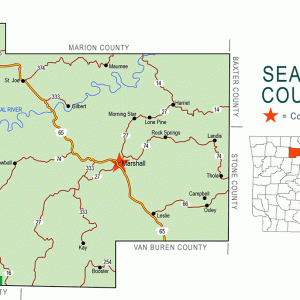calsfoundation@cals.org
Gilbert (Searcy County)
| Latitude and Longitude: | 35º59’16″N 092º42’58″W |
| Elevation: | 594 feet |
| Area: | 0.37 square miles (2020 Census) |
| Population: | 26 (2020 Census) |
| Incorporation Date: | February 13, 1913 |
Historical Population as per the U.S. Census:
|
1810 |
1820 |
1830 |
1840 |
1850 |
1860 |
1870 |
1880 |
1890 |
1900 |
|
– |
– |
– |
– |
– |
– |
– |
– |
– |
– |
|
1910 |
1920 |
1930 |
1940 |
1950 |
1960 |
1970 |
1980 |
1990 |
2000 |
|
– |
– |
116 |
106 |
51 |
52 |
45 |
43 |
43 |
33 |
|
2010 |
2020 |
|
|
|
|
|
|
|
|
|
28 |
26 |
|
|
|
|
|
|
|
Gilbert, situated on the Buffalo River in Searcy County, was established at the turn of the nineteenth century, coinciding with the railroad’s moving south from Missouri. The town was named for Charles W. Gilbert, president of the Missouri and North Arkansas (M&NA) Railroad.
As the town grew, it boasted four stores, two hotels, several sawmills, and three doctors. A new church was presided over by the Reverend John A. Battenfield from Illinois. Town historian Ray Jordan said Battenfield’s commanding voice captivated people as if he had preached for only moments, although he often preached three or more hours. His followers, a millennialist group called the Incoming Kingdom Missionary Unit, printed a weekly newspaper, the Kingdom Harbinger, beginning in October 1920.
Gilbert Cemetery was founded in 1920 at the top of the hill on Frost Street, located three miles from Highway 65. The land for the cemetery was donated by C. Eli Jordan, and the first person to be buried there was Barbara Ellen Beckel, who was born in Switzerland in 1845.
The Gilbert Saloon, owned by Uriah Still, was the first and only saloon during the town’s heyday. In August 1915, the Buffalo River flooded, and the saloon, which was west of the depot and between the railroad and the river, washed away along with the Eagle Pencil Company mill on August 18. A man tried to stabilize the saloon by wrapping several coils of cable around the building and attaching the end to the railroad tracks, but the cable snapped, and the saloon was lost. The water reached an all-time high, cresting at 59’2″. According to rumor, full bottles of liquor still rest at the bottom of the Buffalo.
Gilbert School District Eighty-eight was formed on June 10, 1921. For the first three years, school was held in an old store and then in the church. Eli Jordan donated land to build a school, and residents donated money for lumber and materials. Anyone with a team and wagon hauled in the lumber, and the men of Gilbert built the school.
By the early 1940s, the railroad moved on, the timber industry slowed, and Gilbert began to fade. Only a small part of the railroad remains—the bridge that crosses Dry Creek.
The National Weather Service recognizes Gilbert as one of the coldest towns in Arkansas. Ray Jordan’s father, Eli Jordan, was the town’s official temperature observer for the weather service. One morning in the winter of 1939–40, the temperature dropped to minus twenty-four degrees Fahrenheit. On April 6, 1969, Gilbert had lows below freezing in the early hours but warmed to ninety degrees by afternoon. Gilbert’s highest reading was 108 degrees in September 2000.
Gilbert has many attractions, including boating, rafting, and fishing along the Buffalo. The biggest attraction is the Gilbert General Store, which was built in 1901 by “Uncle” Billy Mays and is on the National Register of Historic Places. The store is one of the last of its kind in the Ozark Mountains. Craig Ogilvie, travel writer for the state Department of Parks and Tourism, wrote in a May 1977 National Geographic article on the Buffalo National River: “The original mercantile flavor remains unchanged despite the passing years. Everything from buttons and axe handles to crackers and cheese are stocked in the homemade shelves and long glass display cases. The business is owned by Mike and Evelyn Mills, but until 1979, the store had been a part of the Mays-Baker families….Until the 80’s, a corner of the store served as the post office.”
The post office later came to be operated out of a separate building on Frost Street, and Benjamin and Cynthia Fruedahuf bought the store.
By 2022, after five years of effort, the town of Gilbert had replaced its high-pressure sodium streetlights with LEDs in an effort to cut down on light pollution, following along the lines of the Buffalo National River, which became Arkansas’s first International Dark Sky Park in 2019.
For additional information:
Bowden, Bill. “Gilbert Gets Sky Back with New Streetlights.” Arkansas Democrat-Gazette, October 16, 2022, pp. 1A, 13A. Online at https://www.arkansasonline.com/news/2022/oct/16/arkansas-smallest-town-replaces-streetlights-with/ (accessed October 17, 2022).
Searcy County, Arkansas. 2nd ed. Dallas, TX: Taylor Publishing Co. and Searcy County Museum, 1986.
Thompson, Doris. “History of an Ozark Utopia.” Arkansas Historical Quarterly 14 (Winter 1955): 359–373.
Barbara Sloan
Marshall, Arkansas
 Recreation and Sports
Recreation and Sports Buffalo River at Gilbert
Buffalo River at Gilbert  Gilbert Street Scene
Gilbert Street Scene  Gilbert Takeover
Gilbert Takeover  Gilbert Train Depot
Gilbert Train Depot  Searcy County Map
Searcy County Map 




Comments
No comments on this entry yet.